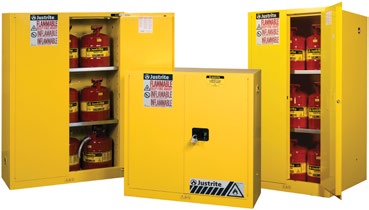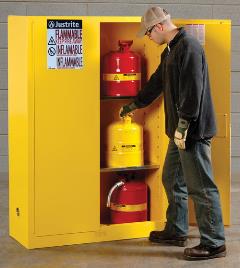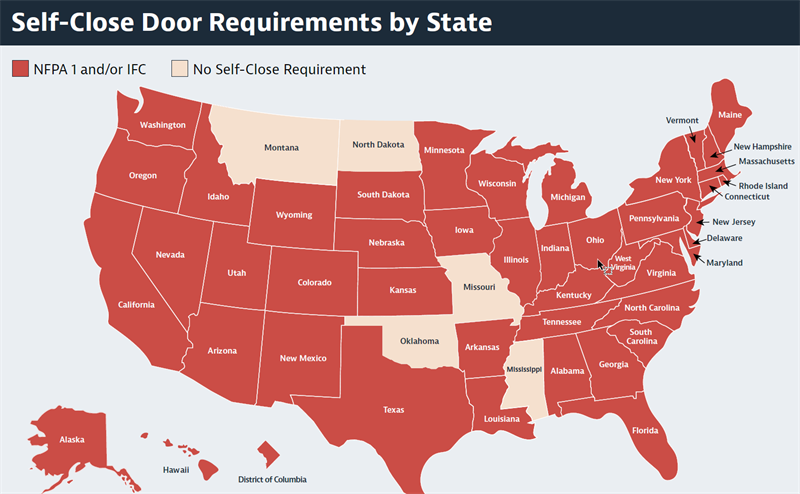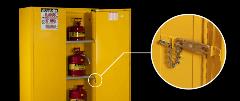Safety Cabinets: Why Do You Need Them and Are You Compliant?

Why Do I Need a Safety Cabinet?
One of the leading causes of industrial fires is the improper storage and handling of flammable liquids. Safety cabinets help you safely store fuels, chemicals, and solvents to reduce the risk of fire and protect your people and property.
Safety Cabinets Serve Critical Functions
- Improve awareness—high-visibility cabinet color and prominent labeling identify potentially hazardous chemicals
- Keep dangerous liquids safely organized and segregated—for indoor use
- Increase maximum allowable quantities of flammable and combustible liquids in control areas
- Improve efficiency by locating materials near point-of-use
- Improve security with locking mechanism
- Ensure safe evacuation time in the event of a fire
- Provide compliance with federal OSHA regulations and the National Fire Protection Association
Approvals & Compliance
- OSHA 1910.106
- National Fire Protection Association (NFPA) Flammable Liquid Code 30
- NFPA Fire Code 1
- International Fire Code (IFC)
- National Fire Code of Canada
- NFPA Hazardous Materials Code 400
- European EN standard 14470-1 and 14727
Most cabinets carry independent, third-party approval:
- FM Approvals
- MPA Dresden
 Considerations When Selecting a Safety Cabinet
Considerations When Selecting a Safety Cabinet
- Federal, state, and local compliance requirements
- Size and type of container being stored
- Capacity needed
- Type of chemical being stored
- Security and safety features such as U-Loc™ padlockable handle, SpillSlope® shelves, Haz-Alert™ warning labels, all welded construction
Many states have updated code regulations on flammable cabinets. Yours may not meet current code requirements.
What has changed?
The new specification calls for a safer, flammable cabinet with self-closing doors that shut automatically in case of a fire.
Why the change?
- A flammable cabinet with open doors provides no fire mitigation benefit.
- In a fire, it is a safety hazard for a person to try and close the doors.
- Self-closing cabinets ensure doors latch properly.
Self-Close Door Requirements by State
Often state or local fire code requires safety cabinets with self-close doors. The following reference chart illustrates the adoption of the IFC codes by state requiring self-close doors on Flammable Liquid Safety Cabinets. We recommend customers check with local authorities having jurisdiction as local codes may prevail.

This information was valid 2012 and is for reference only. Please confirm with your regulatory agencies and consult with your state and local codes for most up to date information. This information is subject to change and is not warranted.
Connect with Saf-T-Gard to earn More
Saf-T-Gard supplies safety cabinets for every application. Self-Close Flammable Safety Cabinets feature a 3-Step Self-Close System for reliable and effective flammable liquid storage:
 Fusible Link - This thin metal strip will melt if the cabinet temperature reaches approximately 165°F (74°C).
Fusible Link - This thin metal strip will melt if the cabinet temperature reaches approximately 165°F (74°C).- Door Spring - Once the fusible link melts, the door springs trip and the door forces shut with inertia.
- Latch Engagement - After the spring has forced the door shut, a latch engages, ensuring the door remains securely closed.
Industrial safety is our legacy going back 9 decades. For an overview of all our Justrite® Safety Cabinets, including those with manual and self-close doors for storage of flammables, corrosives/acids, and combustibles, and to order for immediate shipment, please visit Justrite.

